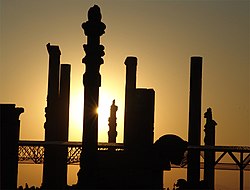Marv Dasht
|
Marvdasht مرودشت |
|
|---|---|
| city | |

|
|
| Coordinates: 29°52′27″N 52°48′09″E / 29.87417°N 52.80250°ECoordinates: 29°52′27″N 52°48′09″E / 29.87417°N 52.80250°E | |
| Country |
|
| Province | Fars |
| County | Marvdasht |
| Bakhsh | Central |
| Population (2016) | |
| • Total | 148,858 |
| Time zone | IRST (UTC+3:30) |
| • Summer (DST) | IRDT (UTC+4:30) |
Marvdasht (Persian: مرودشت, also Romanized as Marv Dasht) is a city and capital of Marvdasht County, Fars Province, Iran. At the 2006 census, its population was 123,858, in 29,134 families.
Marvdasht is as ancient as the history of Iran and the Persian empire. Its former capital Persepolis is in the vicinity of the city, and few kilometers farther Naqsh-e-Rostam, Naqsh-e Rajab and the ruins of the ancient city of Estakhr are reminiscent of the region's importance in historic times. Archeological excavations have shown that civilized people had already been living in the Marvdasht Plains for millennia when Darius decided to choose the plains of mount Rahmat for his royal residence.
The modern city of Marvdasht was constructed in the 20th century. After the Pahlavi government built a sugar factory in 1935 (1314 persian calendar), the city gradually developed around the factory: More and more people left the nearby villages or abandoned their nomadic life to settle in the developing city. People from farther areas also migrated to the city. In the years before the Islamic Revolution Marvdasht became the most important industrial city of Fars province, as other factories such as the petrochemical complex, Azmayesh (producing household appliances and intended to be biggest in the middle east), the Charmineh leather factory, the Fars meat complex and the Dadli biscuit company were constructed. These required a huge workforce, and the population of Marvdasht increased until it became the second most populated city in Fars province. The fertile lands around the city were cultivated to make Marvdasht into the major center of Iranian agriculture, producing more wheat, maize, tomato, cucumber and other agricultural products than any other region.
...
Wikipedia

